The Space Shuttle Decision:
Chapter 8: A Shuttle to Fit the Budget Chapter 8: A Shuttle to Fit the Budget
Chapter 8: A Shuttle to Fit the Budget
Introduction
In May 1971, the Office of Management and Budget (OMB) proposed to limit NASA’s spending to a peak of $3.2 billion during the next five years. George Low, working with his NASA associate Willis Shapley, responded by proposing a constant budget, with shuttle spending rising no higher than a billion dollars per year. Low would later describe this approach as “the only one which could convince the OMB that we could do the shuttle and at the same time have a balanced space program.” Unfortunately, this billion-dollar limit left NASA with funds to build an orbiter but not a booster. Could the agency find a way to build both?
The Orbiter: Convergence to a Good Solution
As early as 1969, during the initial Phase A studies, Lockheed had taken the initiative in proposing a two-stage fully-reusable design with both stages built of aluminum and using silica tiles for thermal protection. While the final design for the shuttle orbiter would in fact use this approach, one must not think that Lockheed was prescient. Though that company indeed was in the forefront in developing such tiles, they were items for laboratory research. A design that specified their use had no more intrinsic credibility than one that proposed to use the miracle metals Unobtanium and Wishalloy. Nevertheless, the work at Lockheed suited an emerging preference within the Air Force.
Late in 1969, Air Force officials stated that they wanted to build the orbiter using a conventional aluminum airframe, along with whatever form of thermal protection would be appropriate. In contrast to strong reliance on titanium in hot structures, this preference for aluminum stemmed from an Air Force finding that the aerospace industry faced a shortage of the specialized machine tools needed to fabricate large structural parts from titanium alloy.
Within NASA and its contractors, design studies weighed the relative merits of aluminum and titanium as primary structural materials. The aluminum airframe promised to be lighter in weight, reflecting the fact that aluminum is lighter than titanium. It also would be less costly to build, reflecting the industry’s long experience with aluminum. By contrast, titanium structures promised to cost up to three times as much as their aluminum counterparts, and would carry greater risk in development.
Titanium, however, could overcome these disadvantages with its ability to withstand temperatures of 650 °F, compared with 300 degrees for aluminum. This brought a considerable reduction in the weight of the thermal protection, for two reasons. The temperature resistance of titanium would make it possible to build the top areas of the wing and fuselage of this metal alone, without additional thermal protection, for they would be shielded against the extreme temperatures of re-entry by the bottom of the vehicle. In addition to this, a titanium structure could function as a heat sink, absorbing some heat and thereby reducing the thickness and the effectiveness of thermal protection where it would be needed.
Overall, the advantages of titanium promised a complete orbiter, including thermal protection, that would weigh some fifteen percent less than a counterpart built of aluminum. With the titanium orbiter requiring less thermal protection, it also would cost less to refurbish between missions. Though the higher cost and risk of titanium would militate in favor of aluminum once NASA faced the OMB’s cost ceiling, the merits of titanium encouraged its use during NASA’s design work of 1970 and 1971. [Aviation Week, January 18, 1971, pp. 36-39; Jenkins, Space Shuttle, pp. 67, 95; letter, Low to Professor John Logsdon, January 23, 1979.]
The Phase B studies represented the main line of effort, with John Yardley directing the work at McDonnell Douglas and Bastian Hello managing the activity at North American Rockwell. Both contractors proposed fully-reusable orbiters, carrying all propellant tankage within the fuselage. They looked like large delta-winged fighter planes; indeed, the McDonnell concept somewhat resembled that company’s F-4 Phantom aircraft, which were seeing extensive use in Vietnam. [Aviation Week: April 5, 1971, pp. 36-38; June 7, 1971, pp. 55-61.]
Both orbiter concepts called for building the propellant tankage of aluminum. Though the tanks would be empty of propellant during reentry, they would require insulation to keep their contents — liquid hydrogen and liquid oxygen — from evaporating. That same insulation then would protect the aluminum from heat that would soak through the thermal protection. Similarly, the crew compartment was to be of aluminum, with the crew members riding amid an insulated and air-conditioned coolness that would protect the adjacent structure from overheating as well.
In the structural frames and outer skin of the wings and fuselage, the contractors proposed to use titanium freely. They differed, however, in their approaches to thermal protection. McDonnell Douglas continued to favor hot structures, with insulation to protect the underlying framework and temperature-resistant metal panels facing the heat of reentry. Metallurgists had developed specialized alloys of nickel and cobalt for the turbine blades of jet engines; these metals resisted oxidation when hot, making them suitable for the skin of this orbiter. For instance, most of its underside was to be covered with shingles of Hastelloy-X, a chrome-nickel alloy. The wing leading edges would use struts and beams of columbium; shingles of coated columbium protected areas that were too hot for Hastelloy. Though only a small coterie of engineers had experience with such materials, the McDonnell Douglas designers were not reticent about pushing the state of the art. [AIAA Paper 71-804; Report MDC E0308 (McDonnell Douglas).]
North American also had a strong interest in titanium hot structures, expecting to use them as well on the upper wing surfaces and the upper fuselage. Everywhere else possible, this company’s design called for applying thermally-protective tiles directly to a skin of titanium. Such tiles would cover the entire underside of the wings and fuselage, along with much of the fuselage forward of the wings. The main exceptions included the nose and leading edges, protected with carbon composite, and the vertical fin, designed as a hot structure with a skin of Inconel 718, a heat-resistant nickel steel. [AIAA Paper 71-805; Reports SV 71-28, SD 71-114-1 (North American Rockwell).]
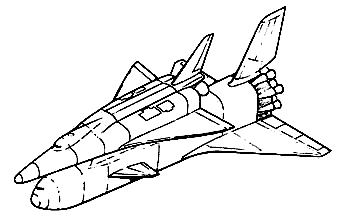 Fully-reusable shuttle of North American Rockwell. (North American Rockwell) |
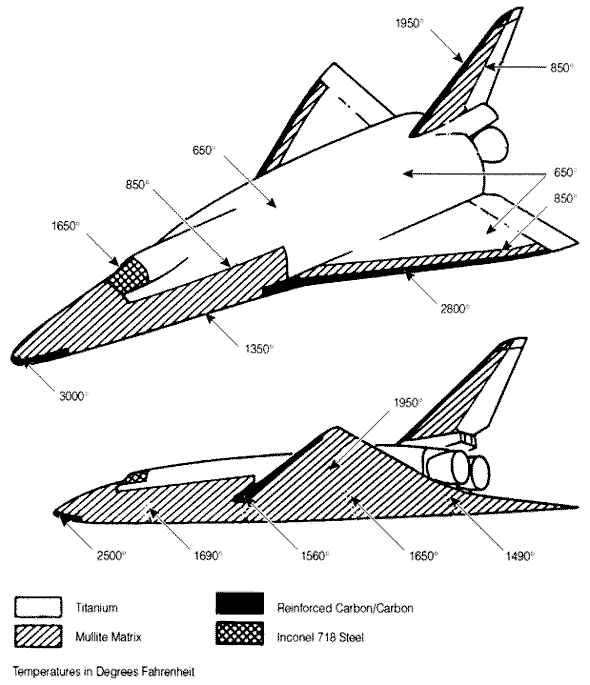 Thermal protection on the North American orbiter. (North American Rockwell) |
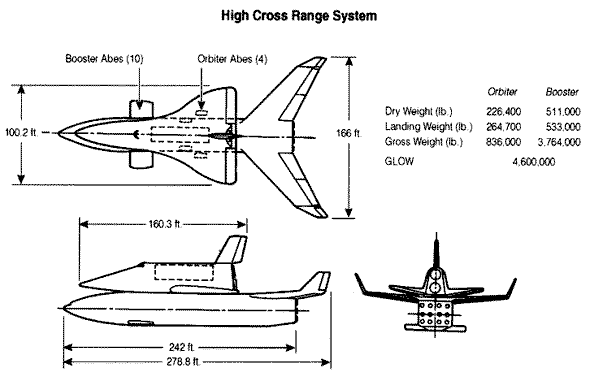 Fully-reusable shuttle of McDonnell Douglas. (NASA) |
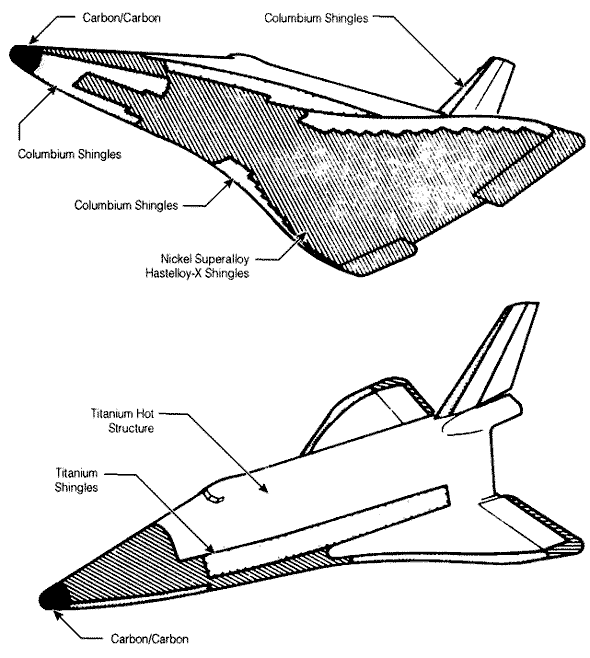 Thermal protection on the McDonnell Douglas orbiter. (McDonnell Douglas) |
These orbiter concepts represented the fruit of several years of experience in the design and study of two-stage fully-reusable shuttles. They also were quite representative of what NASA now would not be able to build, under the fiscal limits of the OMB. The agency, however, had an ace in the hole, for in parallel with these Phase B efforts, Lockheed and Grumman had been pursuing studies of alternatives.
For both companies, the point of departure lay in partially-reusable configurations that would carry their propellant in expendable tanks. This offered a route to lower development cost because the orbiter could shrink in size by carrying its propellant externally. The tanks could take form as simple aluminum shells, while the orbiter would have much less volume to enclose within its hot structures, and much less surface area to protect thermally.
Such approaches dated to the original Star-Clipper concept of 1965. They had lost favor because the throwaway tankage would cost money, in dollars that literally would be thrown away. Partial reusability was attractive to the OMB because it would cut the all-important development cost, the year-to-year line item in the federal budget. NASA’s fully-reusable approach promised huge up-front costs in return for the vague hope of large savings after everyone had retired, through reduced cost per flight. The OMB insisted on smaller short-term outlays in exchange for the prospect of a somewhat greater cost of launch, 15 years down the road. The OMB held most of the cards.
Among the alternative shuttle designs, Lockheed was continuing to examine variants of Star-Clipper, with a lifting body for its core vehicle and external tanks flanking this core. The new versions included a two-stage fully-reusable design that placed the propellant tanks within the core and used a McDonnell Douglas shuttle booster as the first stage. NASA by now had little interest in lifting bodies, for they promised difficulty in development along with high landing speeds. With the main line of design activity now defined by delta-winged versions of Max Faget’s two-stage rocket airplanes, NASA’s continuing support of Lockheed amounted to telling the OMB: Since you want us to look at alternatives, here is what we have. [Report LMSC-A989142 (Lockheed); Jenkins, Space Shuttle, pp. 98-103.]
By contrast, Grumman began its examination of alternative designs with no preconceived views as to how to proceed. When the work began, in mid-1970, this company started with 29 configurations in three categories: two-stage fully reusable, reusable orbiter with expendable booster, and reusable orbiter with expendable propellant tankage. Like everyone else, the Grumman manager, Lawrence Mead, concluded that full two-stage reusability would be best in the long run. His report, however, noted pointedly that the other approaches offered promising means of reducing the peak funding.
Meanwhile, during the fall of 1970, the Grumman group supplemented its NASA funds with company money, to broaden further the range of alternatives. The most promising modified the basic two-stage fully-reusable approach by removing the orbiter’s liquid hydrogen fuel from within its fuselage, and storing it in a pair of expendable tanks. Grumman managers presented this concept to officials at the Manned Spacecraft Center in November 1970. Within weeks, these managers were instructed to concentrate their efforts on further and more detailed study of this expendable-tank orbiter, and to compare it with a fully-reusable variant having internal tankage. This approach gained further favor in March 1971, as NASA instructed McDonnell Douglas and North American Rockwell to develop variants of their fully-reusable configurations that would also place the orbiter’s liquid hydrogen within expendable tankage. [Report B35-43 RP-11 (Grumman), Section 1; Aviation Week, March 29, 1971, pp. 45-46.]
Why was this approach so promising? Liquid hydrogen is bulky, having only one-fourteenth the density of water. Thus, although it makes up only about one-seventh of a shuttle’s propellant load by weight, with six-sevenths being liquid oxygen, liquid hydrogen accounts for nearly three-fourths of the volume. Being low in density and hence light in weight, this fuel could be carried in external tanks of similar light weight. Being bulky, its removal would bring a welcome reduction in the vehicle size and surface area.
In addition, Grumman’s approach brought a useful shrinkage in the size and weight of the complete two-stage shuttle, including the booster. In designing two-stage vehicles, standard procedures exist for choosing the best staging velocity, so as to achieve the lowest weight of the two stages together. At a higher staging velocity, the first stage becomes excessively large and heavy; at a lower velocity, the orbiter requires more size and weight. Ground rules set at Marshall Space Flight Center, based on such optimization, defined this staging velocity as being close to 10,000 feet per second. For Grumman’s two-stage fully-reusable configuration, used as a reference for purpose of comparison, it was 9750 ft/sec.
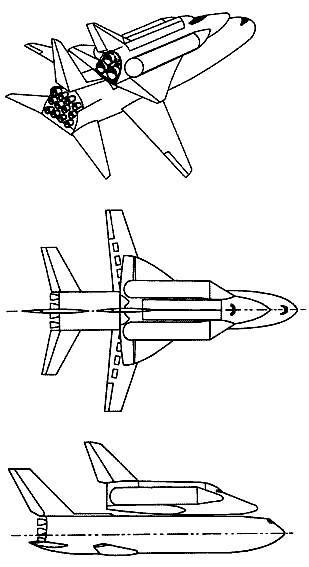 Grumman’s two-stage shuttle, which put the orbiter’s liquid hydrogen in expendable tanks. (Art by Dennis Jenkins) |
With the liquid hydrogen now to be carried in lightweight external tankage, a re-calculation of this optimum showed that it would be advantageous to make these tanks larger, allowing them to carry more of this fuel. The orbiter then would have to carry more liquid oxygen, stored within its fuselage. This, however, would be easy to accommodate. Liquid oxygen is dense, denser than water. Hence, the extra quantity would require little additional volume and would not compromise the overall design of the orbiter.
The upshot was that the optimum staging velocity, concomitant with the lowest overall weight, would drop to only 7000 ft/sec. This would greatly ease the task of designing the booster. The booster now could be considerably smaller and lighter in weight, reflecting its reduction in required performance. It also would be much easier to protect thermally.
The orbiter design followed standard practice, with a main structure of titanium. Grumman’s report stated that the company would rely on “materials, analysis, manufacturing and test procedures developed for the F-14 aircraft,” a Navy fighter that was just entering service. The orbiter’s thermal protection was to rely primarily on hot structures, in the fashion of McDonnell Douglas, with carbon composite and silica tiles at the nose and leading edges. The use of external tankage cut the dry or unfueled weight of the complete two-stage shuttle by nearly one-third, from 1.02 million pounds to 692,000 pounds. In the words of the report, this weight saving “means structure we eliminate from design, do not provide tooling for, nor build, maintain, refurbish or otherwise pay for.”
This comparison of weights drew on the fact that Grumman had worked to encourage such comparisons deliberately, by carrying through studies of designs with both external and internal orbiter tankage, according to the same ground rules. The report noted that
for those who have in the past undertaken to compare configurations from several contractors, the necessity for a dual effort of this nature is readily apparent. There is nothing more frustrating and inaccurate than to attempt to compare weight, performance, and cost from several contractors, using, by definition, their own unique preliminary design groundrules and criteria.
As a consequence, Grumman’s work had to be taken seriously when it pointed to financial advantage:
| . | Fully Reusable | External Hydrogen |
| . | ||
| Development cost, $ M | 7,777 | 6,497 |
| Peak funding, $ B | 2.20 | 1.85 |
| Cost per flight, $ M | 4.29 | 4.22 |
The peak funding level, $1.85 billion, was a long way from the OMB requirement of $1 billion. Nevertheless, it was $350 million closer to this goal than the fully-reusable design. Moreover, in a brilliant example of having one’s cake and eating it, Grumman proposed that the expendable tankage would actually reduce the cost per flight. The tanks per se would cost $740,000 per flight. Other savings, however, would more than offset this, with the largest of them stemming from a substantial cut in the amount of propellants for a flight, and from eliminating the need to refurbish the thermal protection of the now-simpler booster. [Report B35-43 RP-11 (Grumman); Aviation Week, July 12, 1971, pp. 36-39; Powers, Shuttle, p. 240.]
While Lockheed’s Star-Clipper was widely known for its use of external tankage, it used no booster, relying on a single set of engines in the core to carry it from liftoff to orbit. The use of a reusable booster, however, in conjunction with expendable tankage on the orbiter, now opened new prospects to explore. An important group of explorers worked at McDonnell Douglas, where they proposed particularly large external tanks that would allow the orbiter to ignite its engines at liftoff, with these engines burning all the way to orbit. Though this shuttle still needed a booster, its staging velocity fell even further, to 6200 ft/sec. This booster’s dry weight, 346,000 pounds, was only three-fifths that of the booster in the fully-reusable system. For the complete two-stage shuttle, cost of development dropped from $9.82 billion to $8.67 billion, yielding a reduction on a par with that projected by Grumman. [Report MDC E0376-1 (McDonnell Douglas).]
Another group of designers worked with Max Faget at NASA’s Manned Spacecraft Center. Decisions dating to early 1970 had given that center responsibility for technical direction of orbiter concepts, with NASA-Marshall receiving similar responsibility for boosters. Faget had responded by initiating studies of a succession of two-stage, fully-reusable configurations, indulging to the full his taste for straight wings and for lightweight payloads in small payload bays that would suit the mission of space-station resupply. In January 1971, when NASA officials had met with Air Force counterparts, they had agreed that the orbiter should have delta wings along with a payload capacity of 60 x 15 feet and 65,000 pounds. Faget, nevertheless, had gone his merry way, as if this agreement did not apply to him. He continued to pursue his personal preferences in shuttle design; it was well into 1971 before he caught up with the rest of the world.
He knew a good thing when he saw it. Although he had strongly advocated the fully-reusable orbiter with internal tankage, he quickly turned to designs with expendable tanks. The Grumman and McDonnell Douglas concepts had carried their hydrogen in long cylinders running alongside the orbiter fuselage, just above the wing. As early as May 1971, Faget prepared a set of drawings designated MSC-020 that put the hydrogen in a single tank, slung beneath the front of the vehicle. This concept followed his preferences by specifying straight wings, a 20,000-pound payload, and a 30 x 15-foot bay. It showed that, at least in this respect, he was willing to change with the times.
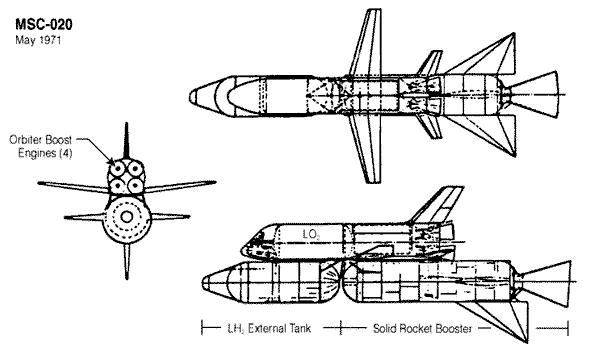 First of four drawings showing how Max Faget adopted external tankage and moved toward the final orbiter concept, 1971. (Art by Dennis Jenkins) |
The next step was to lengthen this single external tank to allow it to carry liquid oxygen as well. This would reduce the size of the orbiter to a bare minimum. The tank, attached to the orbiter’s belly, would demand structural strengthening, for its store of liquid oxygen would be quite heavy. With all propellant removed from the orbiter, that vehicle could achieve a standard design, independent of the tank. The tank could grow to a particularly large size, further lowering the staging velocity of the booster. In turn, this lower staging velocity would further reduce the size of the booster, cutting the cost of the Shuttle program anew.
The first such concept, the MSC-021, came forth during that May. Again, it featured straight wings and the same payload weight as in the MSC-020. Though the bay now had a length of 40 feet, it still was much shorter than what the Air Force would accept. During that same month, Faget also proposed the MSC-023, again with all propellants for the orbiter in a single large underbelly tank. It featured delta wings and a full-size bay, 15 x 60 feet. Here, for the first time, was the outline of a shuttle orbiter that would actually be built.
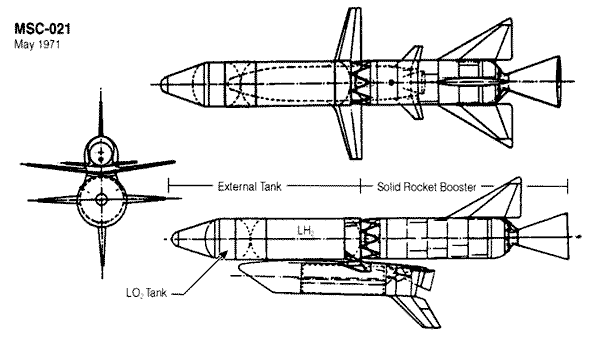
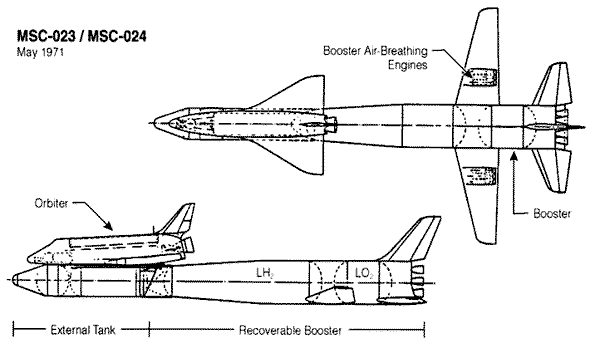
Even so, Faget was not ready to offer an uncritical embrace of delta wings and large payload bays. Though he now had an external tank that he liked and would stick with, his subsequent designs continued to show small bays and straight or swept wings, and sometimes both. He also examined a number of variations in the arrangement of the orbiter’s main engines. Though the MSC-023 had only a single such engine, in June he released the MSC-037, amounting to a variant with three engines and a 40,000-pound payload. It matched the final design in important respects.

The contractors quickly followed this lead, as they launched new studies that assessed its merits. Grumman, which initially put only the hydrogen in external tanks, declared that an orbiter such as the MSC-037 was at least as promising. Lockheed, McDonnell Douglas and North American found that it was superior, with all three firms giving it a strong endorsement. Indeed, as early as September 1, North American presented its own version of the MSC-037, singling out this design as the one to pursue. An artist’s rendering showed an orbiter closely resembling the one that NASA would build. Eleven days later, NASA formally instructed its contractors to adopt a variant, the MSC-040, and to use it as a basis for comparison within their ongoing studies. [Jenkins, Space Shuttle, pp. 107-116; Hallion, Hypersonic, pp. 1018, 1048-1068; Reports SV 71-40 (North American Rockwell); (Grumman); LMSC A-995931 (Lockheed), Section 1, Interim Report (McDonnell Douglas).]
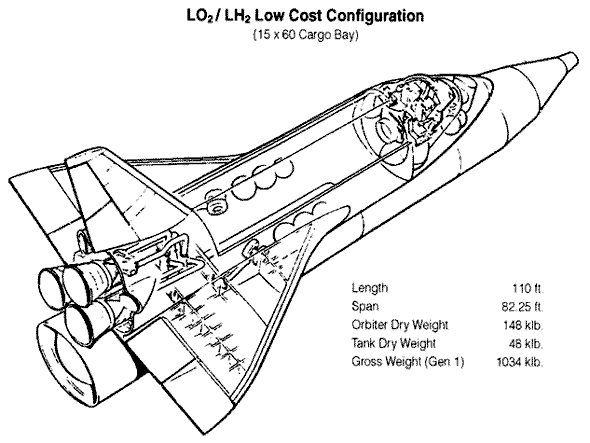 Orbiter concept of September 1, 1971, which foreshadowed the shuttle that NASA would build. (North American Rockwell) |
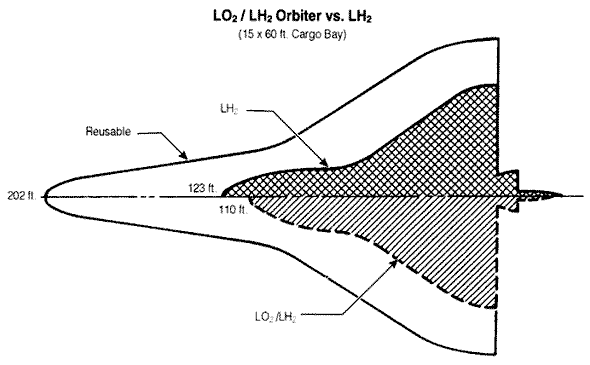 Shrinkage of the shuttle orbiter. Planforms compare the sizes of the fully-reusable orbiter with internal tankage; the orbiter with internal LO2 and with LH2 in external tanks; and the final orbiter, with all propellants carried externally. (North American Rockwell) |
The Booster: Confusion and Doubt
In contrast to the rapid convergence of the orbiter designs, the booster studies fell into disarray. The initial points of reference lay in the Phase B booster concepts of McDonnell Douglas and North American Rockwell. Both contractors proposed vehicles somewhat larger than a Boeing 747, and weighing some five times as much when fueled. The North American concept had two dozen engines: 12 SSMEs and 12 jet engines, the latter serving during flyback to the launch site. McDonnell Douglas’s booster, only slightly less ambitious, was to use a dozen SSMEs as well, with ten turbojets.
The North American orbiter had featured a primary structure and skin of titanium, with tiles providing most of the thermal protection. The booster design was more eclectic. Its front section, which enclosed the crew compartment, had frames and skin of René 41, a nickel-chromium alloy that contained cobalt and molybdenum. Though it was strong and oxidation-resistant, it was hard to fabricate. Wings, vertical fin and canards, small forward-mounted winglets used for control, all were of titanium. The fuselage and its tankage were largely of aluminum.
Then came the thermal protection, which avoided the use of tiles in favor of hot structures. The designers might have simplified matters by specifying the wide use of tiles, as on the orbiter. Tiles, however, were in their infancy and North American had to show that it also understood the design of hot structures. As usual, bare titanium skin sufficed for the upper surfaces of the wings and fuselage. The underside, nose and forward fuselage, however, were a metallurgist’s delight — or nightmare. The wing leading edges would use coated columbium. Large surface areas would rely on the alloys René 41 and Haynes 188, which were exotic mixtures of nickel, cobalt, chromium, tungsten, and molybdenum. Because these metals would expand when hot, designers proposed to build the thermal protection in the form of shells, free to slide over the underlying structure. On paper, at least, the shells would not come loose.
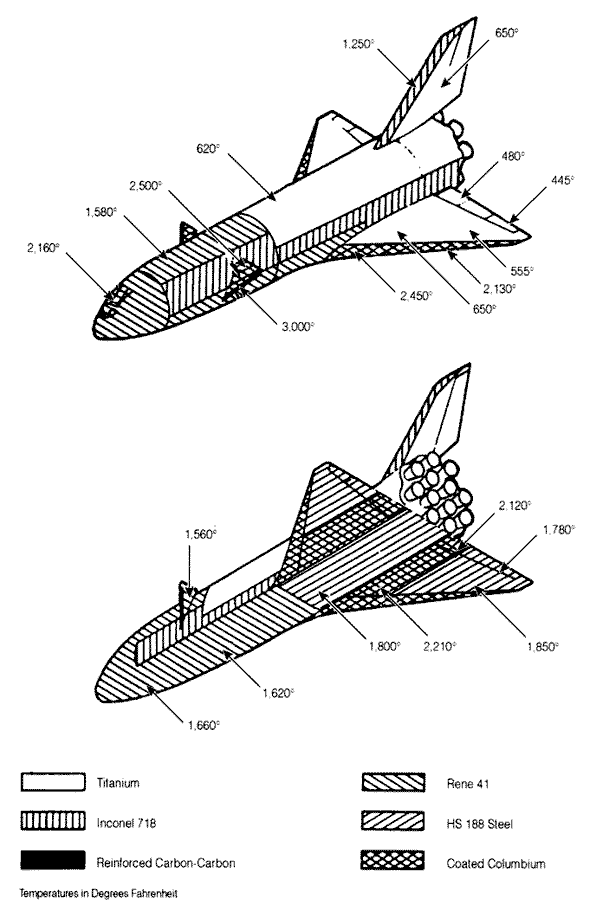 Thermal protection on the North American booster. (North American Rockwell) |
Such a design certainly was not in keeping with the preferences of Max Faget, who always sought the most conservative approach. It was an engineering efflorescence to match the economic efflorescence of the cost-benefit studies at Mathematica, and was likely to raise just as many eyebrows. Moreover, it showed that the exuberance of 1969, when Tom Paine wanted to go to Mars, was still alive. Much engineering experience is summed up in the acronym KISS: Keep It Simple, Stupid. This is what John Yardley’s designers had done at McDonnell Douglas, in crafting their own booster concept.
One can describe it succinctly: aluminum primary structure throughout, including wings, canards, and tail, with tiles of varying thickness to provide the thermal protection. Though metallic shingles would protect the leading edges, they would see use only in the limited areas where tiles would fail to suffice. [Brady and Clauser, Materials, pp. 241, 272; Lynch, Handbook, pp. 552, 822; Aviation Week: January 18, 1971, p. 37; June 7, 1971, pp. 55-61; AIAA Papers 71-804, 71-805; Reports LE 71-7, SD 71-114-1 (North American Rockwell); MDC E0308 (McDonnell Douglas)]
These design exercises gave both contractors the opportunity to conduct detailed investigations using a range of approaches: hot structures, aluminum and titanium primary structures, tiles, and metallic thermal protection. Neither contractor offered anything so simple as an aluminum orbiter protected with tiles, though McDonnell Douglas used this approach in its booster. Despite their complexities, however, the concepts were not obviously infeasible, and some people believed they could actually be built.
Along came the Grumman design studies, which put the orbiter’s liquid hydrogen in external tanks and lowered the booster’s staging velocity from 9750 to 7000 ft/sec. Boeing, which had built the first stage of the Saturn V, was teamed with Grumman and had responsibility for the booster. Its engineers determined that this reduction in velocity would bring a disproportionate reduction in the size and weight of the booster, which now would require much less propellant. In addition to this, the lower velocity meant that the booster would be much closer to the launch site when it released the orbiter and began its return. Being closer, it would need less fuel for its jet engines, further reducing its size. The upshot was that whereas the fully-reusable orbiter’s booster would have a dry weight of 798,500 pounds, the new orbiter would cut this booster weight to 494,900 pounds.
Better still, the lower staging velocity virtually eliminated the need for thermal protection. The booster now would need neither tiles nor exotic metals. Instead, it would use its structure as a heat sink, just as with the X-15. During reentry, it would experience a sharp but brief pulse of heat, which a conventional aircraft structure could accept and absorb without exceeding temperature limits. Hot areas would continue to demand a titanium hot structure, which would cover some one-eighth of the booster. The rest of this vehicle, however, would make considerable use of aluminum.
How could bare aluminum, without thermal protection, serve in a shuttle booster? It was common understanding that aluminum airframes would lose strength due to aerodynamic heating at speeds beyond Mach 2; higher speeds required titanium, with its greater temperature resistance. These principles, however, dealt with aircraft in cruise, which would face their temperatures continually. The Boeing booster would reenter at Mach 7. Its thermal environment, however, would resemble a fire that does not burn your hand when you whisk it through quickly. Across much of the underside, the vehicle would protect itself by the simple method of using metal with more than usual thickness, to cope with the heat. Even these areas would be limited, with the contractors noting that “the material gauges [thicknesses] required for strength exceed the minimum heat sink gauges over the majority of the vehicle.” [Report B35-43 RP-11 (Grumman); Aviation Week, July 12, 1971, pp. 36-39.]
In 1954, amid the early feasibility studies that led to the X-15, investigators found, to their pleasant surprise, that they could follow standard aircraft design practice in crafting this research airplane. As a bonus, they also discovered that its metal skin, designed for strength rather than for heat resistance, nevertheless would have enough thickness to serve effectively as a heat sink. Now, in 1971, engineers at Boeing were learning that their booster could offer the same bonus, while providing the convenience of aluminum, the most familiar of metals and the easiest to use.
When McDonnell Douglas went further, introducing an external-tank orbiter that lowered the staging velocity to 6200 ft/sec, its engineers designed a winged booster that was 82 percent aluminum heat sink. Though these designers could have lowered the staging velocity still further, by putting more propellant in the orbiter’s tanks, their selected configuration brought the largest savings in the weight of thermal protection. [Report MDC E0376-1 (McDonnell Douglas).]
Unfortunately, while the move to external tankage brought a welcome reduction in peak annual funding, it took NASA less than one-third of the distance from the $2.2 billion peak funding of the fully-reusables to the $1 billion of the OMB. This move had addressed the easiest part of the problem; the rest of the solution would prove considerably more elusive.
The next step came during June 1971, as the new NASA Administrator, James Fletcher, embraced what his agency had previously rejected: a phased approach to shuttle development. This called for the extensive use of interim systems that would make it possible to build and fly an initial shuttle orbiter, with development of the final systems being delayed for several years. Such an approach would be wasteful, for the interim arrangements would cost money and yet would serve merely as a stopgap. Phased development also carried political risks, for in Washington, few things are so permanent as a temporary solution. If NASA could get any kind of shuttle into space, even one of interim design, it might face strong opposition and long delays before it could win permission to build the Shuttle it truly wanted. A phased approach, however, would spread the program over a term of years, reducing the all-important peak funding level.
Fletcher had formally taken over his office on May 1. On June 16, in his first major decision, he made an announcement:
The preferred configuration which is emerging from these studies is a two-stage delta wing reusable system in which the orbiter has external tanks that can be jettisoned.
Although our studies to date have mostly been based on a concurrent approach in which development and testing of both the orbiter and booster stages would proceed at the same time, we have been studying in parallel, the idea of sequencing the development, test and verification of critical new technology features of the system. We now believe a “phased approach” is feasible and may offer significant advantages.i [Fletcher, statement, June 16, 1971; Aviation Week: June 21, 1971, p. 19; June 28, 1971, p. 16; Gomersall and Wilcox, Working Paper.]
The SSME represented a potentially important element of this approach. It had been slated to receive early attention and funding, for it was to power both Shuttle stages. Its development therefore would pace the entire program. An alternative engine did exist: Rocketdyne’s J-2S was an uprated variant of the J-2 engine used in Apollo. It would lack the performance of the SSME, while delivering considerably less thrust. A cluster of these engines nevertheless would push a shuttle orbiter into space, though with a greatly reduced payload weight. Also, use of the J-2S would permit a delay (potentially a long one) in proceeding with the SSME. Indeed, Max Faget was already incorporating the J-2S in a number of his orbiter designs. [Rocketdyne, Expendable Launch Vehicle Engines; Jenkins, Space Shuttle, pp. 110, 113-115.]
Most of the cuts in peak funding, however, would come by putting off plans to develop a fully-reusable booster, even one of smaller size and simplified design such as one of the new heat-sink versions. NASA instead would fly its orbiter atop an existing rocket stage such as the S-IC, the first stage of the Saturn V. By delaying development of a fully-reusable booster for three years, the agency could cut the peak funding to $1.3 billion per year. This would represent a reduction of nearly a billion dollars from the proposed peak funding levels of the Phase B studies, and would put NASA within hailing distance of the OMB requirement.
While the move to external orbiter tankage represented ingenuity, Fletcher’s decision amounted to desperation. Dale Myers, the Associate Administrator for Manned Space Flight, admitted to Aviation Week that phased development might prove to be impractical. Fletcher himself wrote a letter to a leading shuttle critic, the space scientist James Van Allen: “The political cards are so heavily stacked against this program…that no opposition from the scientific community is necessary. I think you are shooting at a dead horse.” [Letter, Fletcher to Van Allen, July 12, 1971; Aviation Week, June 21, 1971, p. 19.]
Nevertheless, the prospect of an interim booster spurred hope among the contractors that had products ready to offer. Boeing’s situation now was advantageous, for that company’s S-IC was the only immediately-available stage with the power to carry a full-size shuttle orbiter. For Boeing, NASA’s new interest in that stage also represented a reversal of fortune. Only a few months earlier, the firm was looking ahead to an imminent shutdown of its Saturn production facility. Now it could cherish the hope that production of this rocket stage might continue after all.
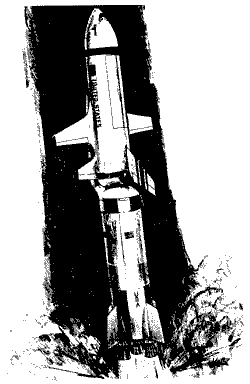 Fully-reusable shuttle orbiter with the S-IC used as an interim first stage. (Grumman) |
Martin Marietta was also in the picture. This firm had actively promoted the Titan III-M, in an era when NASA had been willing to consider a small shuttle orbiter that would amount to an enlarged Dyna-Soar. Though the company had done little of significance for the Shuttle after 1969, now, in mid-1971, it came forward with a new concept, the Titan III-L (“large”). This would use a new liquid-fueled core with a diameter of 16 feet, compared to 10 feet for the standard Titan III, and with up to six solid-fuel boosters of 120-inch diameter.
David LeVine, Martin’s vice-president for launch vehicles, noted that the solid boosters were already in production at United Technology Corp., and could readily be lengthened to yield more thrust. Though the core would be new, it too would use existing engines from Aerojet General. Though the Titan III-L would be expendable, it would cost no more than $30 million per launch, compared to $73 million for the S-IC. The Shuttle orbiter riding atop the new Titan would certainly not resemble Dyna-Soar; it would be a full-size orbiter, carrying up to 65,000 pounds of payload. [Aviation Week: June 28, 1971, p. 16; July 12, 1971, p. 38; August 2, 1971, pp. 40-41; Report MCR-71-309 (Martin Marietta).]
The principal builders of solid rocket motors — Thiokol, Aerojet, United Technology, Lockheed Propulsion Co. — were prepared to make a pitch for their own units as well, arguing that suitable clusters could also provide a good interim shuttle booster. A few years earlier, these firms had built and test-fired rockets with diameters of 156 and even 260 inches. This technology had subsequently been set aside as having no immediate application. Now, however, with the Shuttle needing an interim booster, these big solid motors might see their day.
A fourth approach came from NASA-Marshall: the pressure-fed expendable booster. It amounted to reinventing the liquid-fueled rocket, using approaches selected for their simplicity. Conventional rocket stages used structures of thin-gauge aluminum that saved weight. Their engines relied on turbopumps that pumped the propellants to high pressures, with the engines operating under internal pressures that were similarly high. Such engines offered good performance and strong thrust from compact and lightweight units. The turbopumps, however, were costly and difficult to develop, and at times were prone to failure.
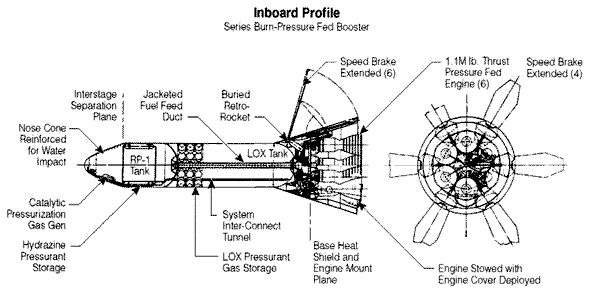 Recoverable pressure-fed booster. (McDonnell Douglas) |
Marshall’s new concept did away with the turbopumps, relying on gas pressure within the propellant tanks to push the fuel and oxidizer into the engines. Though these engines would have to be of new design, their lack of turbopumps would greatly ease the problem of development. They would be larger and heavier than their pump-fed counterparts and would give less performance. Moreover, the booster would gain weight, for it would require heavy thick-walled tanks to contain the pressure. Though this approach was inelegant, flying in the face of the quest for high performance that marked the SSME, it offered one more route toward reducing the peak annual funding. [Jenkins, Space Shuttle, pp. 122-123; Aviation Week, June 28, 1971, p. 16.]
This plethora of possibilities reflected the use of external orbiter tankage, which reduced the staging velocity and made it easier for a booster to do its job. This diversity of boosters meant that there now was no clear reason to choose any of them. The wide range of alternatives recalled the era of the late 1960s, when a hundred flowers had bloomed and when neither NASA nor the Air Force had yet developed a convincing idea of how a shuttle should look.
Though the contractors might have helped by settling on a preferred type of booster, this happened only in part. Early in September, North American declared that all of them appeared acceptable, and recommended deferring a choice. Grumman also found little reason to prefer any of them-but noted that within an interim program of 30 flights or fewer, the S-IC, built by its partner Boeing, would offer lower costs because it was already in hand and would not demand up-front spending for development. Lockheed gave the nod to a cluster of 156-inch solid boosters. McDonnell Douglas did the same, but also had nice words for the Titan III-L. [Reports SV 71-40 (North American Rockwell); LMSC-A995931 (Lockheed); B35-43 RP-21 (Grumman); Interim Report (McDonnell Douglas).]
Having thoroughly muddied the waters with these expendable boosters, NASA officials proceeded to do an about-face as they learned that they might indeed build a reusable booster after all. This happened as further studies of external-tank orbiters showed that they could cut the staging velocity to 5000 and even below 4000 ft/sec. This further enhanced the prospects for reducing the booster size and easing the problem of its thermal protection.
Though it lacked wings, the pressure-fed booster became a candidate for reusability because its thick aluminum skin would easily serve as a heat sink. This same robust skin would allow the vehicle to come down by parachute and land in the ocean, surviving the impact and the subsequent perils of the sea. It would enter the water 200 miles offshore; a boat would then bring it back. No one was prepared to describe this as graceful; with this form of makeshift added to those of its design, the concept was unofficially called the Big Dumb Booster. Such dumbness seemed, however, to promise a new path to wisdom.
A more elegant reusable booster concept came from Boeing, which proposed to remodel its S-IC by turning it into a big airplane. It would receive wings, a tail, a nose with a flight deck, and 10 jet engines for the return to its launch site. Though the standard S-IC had never been built for reentry and reuse, thermal protection would not be a problem; modest thickenings of its aluminum skin now would provide heat sink. To emphasize its short-term feasibility, Boeing’s technical artists presented top and side views in lavish detail, even specifying the location of the onboard power units and the choice of tires for the landing gear. At a time when NASA still expected to defer building a flyback booster for several years, one member of the study team emphasized that “our proposal is the reusable booster.”
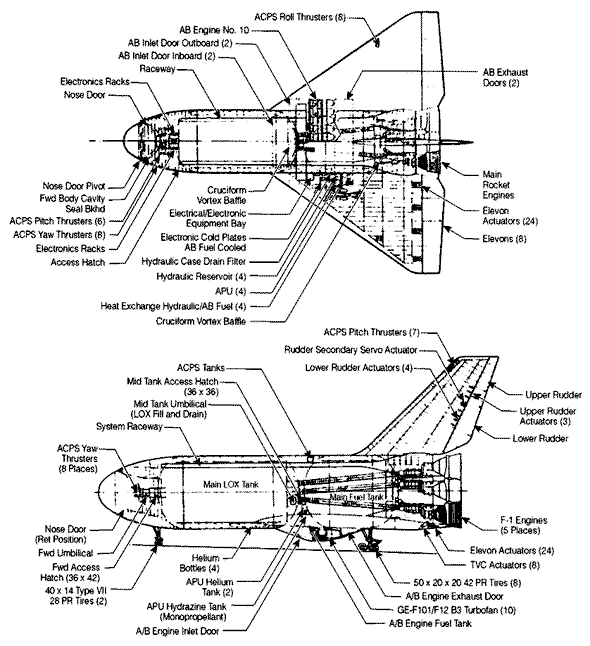 Winged S-IC stage. (Boeing) |
By late September, NASA was ready to abandon phased development, returning to the original plan of simultaneously building the booster and orbiter. The booster would be either the winged S-IC that used standard F-1 engines, or the Big Dumb Booster with pressure-fed propulsion. In turn, the orbiter would use phased technology. It would have a full-size payload bay, but would use four J-2S engines; the SSME program would go on the shelf. For thermal protection, the orbiter would rely on an ablative heat shield, even though this would demand costly replacement after every flight. In time, however, the SSME could be resurrected for use in an upgraded orbiter. This orbiter would also use tiles or hot structures, as reusable and low-cost thermal protection.
The development costs and peak annual funding for the complete Shuttle, in billions of dollars, now looked highly encouraging [Aviation Week: September 20, 1971, pp. 16-17; October 11, 1971, p. 23; October 25, 1971, pp. 12-13; Reports LMSC-A995931 (Lockheed); MDC E-0497 (McDonnell Douglas); B35-43 RP-30 (Grumman); SV 71-50 (North American Rockwell); Ballistic Recoverable (Boeing)]:
| . | Pressure-Fed Reusable | Winged S-IC | ||
| Development | Peak | Development | Peak | |
| . | ||||
| Grumman | $ 4.08 | $ 1.02 | $ 4.50 | $ 1.11 |
| North American | 5.12 | 0.94 | 5.79 | 1.21 |
| McDonnell Douglas | 5.16 | 0.81 | 7.51 | 1.30 |
| Lockheed | (Not given) | 4.41 | 0.99 | |
These costs compared with estimates prepared by the Aerospace Corp. for a two-stage fully-reusable shuttle: development, $9.92 billion, with a peak of $2.34 billion [Morgenstern and Heiss, Analysis, May 31, 1971, p. 0-15]. The pressure-fed booster yielded a development cost less than half that value, with a peak comfortably under the OMB ceiling of $1 billion. The winged S-IC was only slightly more costly, and it preserved all the operational advantages of the fully-reusable boosters of Phase B, on which NASA had placed so much hope.
The new booster concepts did even more, for they addressed major technical deficiencies of the Phase B boosters. Thermal protection had appeared particularly difficult, at a time when tiles were too new to trust. Charles Donlan, the Shuttle program director, put it this way:
Phase B was the first really extensive effort to put together studies related to the completely reusable vehicle. As we went along, it became increasingly evident that there were some problems. You had to develop two hypersonic aircraft configurations, simultaneously. The engine problem was compromised. Trying to use common engines made them not optimized for either case. We ran into a problem of pilot escape from the booster in the event of an abort. We never could quite figure out what to do about it. And then as we looked at the development problems, they became pretty expensive.
We learned also that the metallic heat shield, of which the wings were to be made, was by no means ready for use. The slightest scratch and you are in trouble. It became increasingly evident that you want to have the cheapest possible configuration, but you put all this time and effort on a vehicle, the biggest part of which (the first stage), its only role was to get the orbiter up high enough for it to fly itself. So here you’re spending all this effort on a part of the system that had no basic payoff. The important thing is the orbiter-that is the payoff.
So you see, it was easy to say, “Why do we break our necks putting twelve engines in this damn big reusable booster? You cannot get the pilots away, the metallic heat shield is going to give you all kinds of problems, to do it with ablative stuff makes it too heavy; drop it entirely. That started the ball rolling into other types of boosters for the orbiter.
The merits of an aluminum heat-sink booster appeared stronger yet when one recalls that the most plausible Phase B alternative, which used hot structures in the fashion of the North American Rockwell design, amounted to covering much of the surface of a craft the size of a Boeing 747 with alloys that had previously seen use only in turbine blades. By comparison, the simplicity of aluminum heat sink was overwhelming. It was as much as to say that instead of attempting to leap with one swoop into the metallurgy and launch vehicle design of the twenty-first century, engineers instead could build the booster using design methods that dated to World War II.
The Phase B work had also pointed to demanding issues of safety. To reduce weight to a minimum, the internal tanks had to carry part of the Shuttle’s weights and loads. The resulting stresses would tend to produce leaks. Hydrogen leaks are difficult to detect, raising the prospect that hydrogen could build up beneath the skin of an orbiter, to produce a damaging fire or explosion. External tankage solved this problem, at least for the orbiter. A leak of propellant now might indeed be detected, since it would occur in plain view. The leak would also be far less dangerous, for the propellant would waft away on the winds rather than build up to form a dangerous concentration.
The Phase B shuttles also promised severe difficulty in technical development. Airplanes and spacecraft, as a rule, tend to gain weight in the course of development. A two-stage shuttle could accommodate such weight growth by enlarging the tanks, to allow them to carry more propellant. With the tankage being internal in both stages, this would demand extensive redesign of one or both stages — which would introduce opportunities for further weight growth. External tankage addressed this problem as well. A simple lengthening of the tanks would do, leaving both booster and orbiter untouched. [John Mauer interview, Charles Donlan Washington, October 19, 1983, pp. 19-20; Loftus et al., Evolution, pp. 15-18.]
It thus appeared that in mere months, NASA had scored an impressive coup, addressing these technical issues while simultaneously meeting the OMB’s cost limits. As with the Mathematica study, however, OMB officials again found reason aplenty to view this work with skepticism.
The new configurations closely suited NASA’s institutional arrangements, which dated to the time of Apollo. Those arrangements had given NASA-Marshall responsibility for the Saturn launch vehicles and their engines, with the Manned Spacecraft Center holding responsibility for the Apollo moonship, with its piloted spacecraft and lunar lander. This division of authority had carried over to the Shuttle, with Marshall in charge of the booster and MSC dealing with the orbiter. The Shuttle certainly needed an orbiter; hence MSC’s prospects were clear. It was less obvious, however, that the Shuttle needed a booster, particularly if it was to be complex and costly. At Mathematica, Klaus Heiss had managed the Shuttle studies and now was recommending simplified designs within NASA. He met resistance, and as he told the National Journal, “For a long time some people over there kept seriously telling us, ‘We can’t go that route, because we’ve got to have something for the Marshall Space Center as well as something for the Houston Space Center.’” [National Journal, August 12, 1972, p. 1299.]
NASA-Marshall had taken shape as the lengthened shadow of Wernher von Braun, its founder and longtime director. He and his fellow veterans of the wartime V-2 effort, who still held senior positions, had long since nailed their flag to the mast of liquid-fuel rocketry, and had left the development of large solid rockets to the Air Force. The recent Shuttle studies reflected this strong Marshall preference. Thus, early in September, the prospect had emerged that the Shuttle might use a cluster of 156-inch solids as its booster. Lockheed and McDonnell Douglas had both made outright selections of this choice, while North American and Grumman had found no reason to reject it.
NASA thus had a clear opportunity to seek a phased-development program with these solids as the interim booster. Instead, in a directive dated September 12, NASA had instructed its contractors to set aside their studies of phased development and to return to assessments of concurrent development, using two new reusable booster concepts: the pressure-fed and the winged S-IC. Both had NASA-Marshall written all over them. Of course, Marshall was the world’s leading center for rocket development; its voice would certainly be heard. NASA’s decision, however, had amounted to a peremptory dismissal of solids. The results of the new studies were a little too good to be true. [NASA Tech. Directive GAC-3, 16 September 1971; Reports B35-43 RP-28 (Grumman), p. 11; SV 71-50 (North American Rockwell), pp. 2, 3, 5.]
The winged S-IC, for one, promised the fully-reusable booster of NASA’s hopes. Its shuttle would do nearly everything that the Phase B fully reusables were to accomplish, with a billion dollars less in peak annual funding. Yet because this booster was to grow out of the standard S-IC and would use the F-1 engine, it would continue to demand work aplenty from both Marshall and its contractors. The budget analysts at OMB had been trained to spot flim-flam. They had reason for doubt when they saw that in an astonishingly brief time, NASA had succeeded in devising a new shuttle design with a flyback booster that would make the agency’s wishes come true — while still purporting to meet the cost goals of the OMB.
Projected cost savings also raised questions, for they seemed disproportionately large when contrasted with the relatively modest engineering changes that had led to the shuttle with the winged S-IC. Were the Phase B cost estimates valid? They were certainly high, and if NASA could receive largesse on such a scale, it could continue to maintain itself in the style to which it had become accustomed. On the other hand, one could equally question the low estimates of the recent exercises. Lockheed’s invited particular scrutiny, for it was the lowest-and its peak level, interestingly, was just a hair under the OMB mark of $1 billion. Everyone knew that Lockheed had won the C-5A contract with an unrealistically low bid; everyone also knew that the man who had presided over that bid, Dan Haughton, was now the firm’s chairman. Was Lockheed attempting again to buy in? Were the other contractors very far behind?
Even if one cared to accept everyone’s cost estimates as reflecting good faith, the trend of these estimates invited further questions. On its face, this trend meant that in only six months, NASA had cut the planned cost of development in half, from $10 billion to $5 billion, while sacrificing little in the Shuttle’s capability. These cuts had been won at a price, for the cost per flight was now on the rise-while still remaining low enough, at least in the published estimates, to make the Shuttle attractive to users. Still, it was appropriate to ask if NASA had any other rabbits it might pull from a hat. Thus, late in November two OMB staff members, Daniel Taft and the economist John Sullivan, sent a memo to Donald Rice, an OMB assistant director:
In the light of the innovative Shuttle designs which have been forthcoming over the past several months, we believe that the best procedure would be to provide NASA with a constraint in terms of total investment cost (say, $3-4 B) rather than have us try to define a preferred configuration. If NASA’s resourcefulness to date in changing the Shuttle’s design is any guide, we have not yet begun to see what they could achieve if they really tried to optimize a system for $3-4 B. [Memo, Taft and Sullivan to Rice, November 29, 1971.]
Rice’s domain included the Economics, Science, and Technology Programs Division, which covered NASA. He reported directly to the OMB deputy director, Caspar Weinberger. He, too, had noted that NASA’s recent exercises in redesign had brought the Shuttle very close to what NASA had wanted originally. Four years later, he noted particularly that NASA’s basic assumptions had seemed to be set in concrete:
I guess what sticks in my mind more than anything else about it was the difficulty of getting any solid attention paid to alternative designs. I don’t mean alternative in the technical detail sense, but alternative in terms of mission requirements and why that mattered. How hard it was to get an examination of alternative specifications of what you would like to accomplish, and the systems designs that reasonably derived from that will lead to each different specification of what you wanted to do.
Rice added that within the Pentagon, “they do a hell of a lot better job of looking through the alternatives before they head down one of those roads.” [John Logsdon interview, Donald Rice, November 13, 1975, p. 1.]
Even so, there had been change within the Shuttle program, at least in terms of its engineering design. The two-stage fully reusables were dead, and Charles Donlan would not miss them, later declaring, “It wasn’t till the phase B’s came along and we had a hard look at the reality of what we meant by fully reusable that we shook our heads saying, ‘No way you’re going to build this thing in this century.’ As I say, ‘Thank God for all the pressures that were brought to bear to not go that route.’” [John Mauer interview, Charles Donlan, Washington, October 19, 1983, pp. 23-24.]
The winged S-IC soon would die as well, for it appeared more costly than the pressure-fed reusable booster which, though it might look and fly like an ugly duckling, was a graceful swan in the realm of budgets, and would survive into the next round of designs. This round would resurrect the solid-propellant booster, and would determine the shape of the Shuttle in the form that would actually be built.
End Game in the Shuttle Debate
Within the internal debates of the Executive Branch, the end game, during the second half of 1971, had much in common with the opening gambits of early 1969. Those gambits had featured opposition to NASA’s plans from the Budget Bureau, along with the high-level review panel of Charles Townes that had recommended much less than Tom Paine had hoped to pursue. Now, two and a half years later, a similar review would introduce a concept for a mini-shuttle that would win support from NASA’s critics — and that this agency could not accept.
Congress was not a significant player within these debates, as it remained generally supportive. The flurry of design changes, in the wake of Phase B, did not dent this support. Congressman Don Fuqua, a leader within the House space committee, notes that these changes initially produced “great consternation” among his colleagues:
We had just finished defending one configuration on the floor and then suddenly they announced they were going to change it. Tiger Teague got the top brass from NASA over here and raked them over the coals.
We all wanted to know how long they had known they were going to change and how much of this kind of thing was going on behind the committee’s back. They explained the reasons behind the changes, and everybody calmed down. After that, though events moved pretty fast, they did try to keep us reasonably well informed. [National Journal, August 12, 1972, p. 1294.]
The President’s Science Advisory Committee, however, wanted its own sources of information. Nixon’s first science advisor, Lee DuBridge, had retired in August 1970, citing his wish to step down “well in advance of my 70th birthday in 1971.” His successor, Edward David, had been executive director of communications research at Bell Labs. David inherited the existing staff of the Office of Science and Technology. Within this staff, Russell Drew soon proposed that a new PSAC panel should review the Shuttle’s prospects and offer views on how NASA should proceed. Daniel Taft, an OMB staffer with responsibility for the NASA budget, warmly endorsed this review and urged his management to support it as well.
The resulting panel took shape in mid-1971, with its chairman being Alexander Flax, president of the Institute for Defense Analyses, a Pentagon think tank. In July, at the outset, Rice presented David with a list of questions he hoped that Flax would address. The first meeting of this Flax Committee was a three-day affair in mid-August, far from the heat and humidity of Washington, at Woods Hole, Massachusetts, with Martha’s Vineyard visible across the ocean. The group proceeded to meet about once a month, holding discussions with NASA officials and Shuttle contractors. During the summer and autumn, as these meetings proceeded, NASA replayed anew its familiar struggle with the OMB. [Science: 28 August 1970, pp. 843-844; 18 September 1970, p. 1185; 23 October 1970, pp. 417-419; National Journal, August 12, 1972, p. 1295; memo, Taft to Young, January 22, 1971; letters, Rice to David, July 14, 1971; David to Fletcher, July 26, 1971; memo, Drew to PSAC Space Shuttle Panel members, August 4, 1971; Myers, Memo for Record, August 19, 1971; NASA, “Documentation of the Space Shuttle Decision Process,” February 4, 1972.]
On June 16, when Fletcher announced that he was extending the ongoing contractor studies to consider phased development, he had formally advised the OMB of this in a letter. A month later, in mid-July, Daniel Taft drafted a letter of reply for Don Rice, which asked NASA to “identify an orbiter with minimum performance characteristics.” These would include low crossrange, along with substantial reductions in payload size and weight. Rice’s letter urged Fletcher to place emphasis on “defining approaches which will substantially reduce the overall investment cost” of the Shuttle, citing a number of design approaches that would cover “the full range of alternatives.” Rice, however, did not have to cite a preferred configuration that the OMB would support.
On August 2 the OMB deputy director, Caspar Weinberger, sent a letter to Fletcher that set forth budgetary ceilings for use in preparation of NASA’s budget request for FY 1973, which was due at the end of September:
The planning ceilings established for your agency for the 1973 budget are (in millions):
| Net budget authority | $2,835 |
| Net outlays | $>2,975 |
The above figures provide the basis for developing your 1973 budget submission. The President’s budget decisions require that you submit your budget at or below those figures. [Emphasis in original]…. It should also be understood that subsequent developments may necessitate reducing these planning ceiling amounts; thus, there is no assurance that your final budget allowance will remain at this level.
These budget marks, if enacted, would represent a further and substantial cut from recent levels: $3,268.7 million appropriated in FY 1971, $3,298 million in FY 1972. With such a budget, NASA certainly would not be able to start the Shuttle during the upcoming fiscal year. [NASA SP-4012, Vol. III, p. 12; letter, Fletcher to Rice, June 16, 1971; memo, Taft to Rice, July 15, 1971; letter, Rice to Fletcher, July 20, 1971; letter, Weinberger to Fletcher, August 2, 1971.]
Weinberger was well aware of this. He also knew that these budget marks reflected staff recommendations that had reached his desk by making their way upward through the OMB chain of command. He was willing to listen to Fletcher’s viewpoint as well, and three days later he met with Fletcher and with John Young, the head of OMB’s Economics, Science, and Technology Programs Division. In notes from that meeting, Fletcher presented several conclusions:
1. Come in with budget that meets spec.
2. Present several alternatives (incl. shuttle) which bring us back to 3.2 outlay & maybe 3.27 authority.
3. Cap…didn’t realize manned would be out of business if we made no new starts a la shuttle. Jack Young concurred.
When Weinberger heard that a $2.8-billion budget would mean the end of piloted space flight, he suggested that NASA might be able to stay at the FY 1972 level. On August 12, he wrote a memorandum to Nixon:
Present tentative plans call for major reductions or change in NASA, by eliminating the last two Apollo flights (16 and 17), and eliminating or sharply reducing the balance of the Manned Space Program (Skylab and Space Shuttle) and many remaining NASA programs.
I believe this would be a mistake.
1) The real reason for sharp reductions in the NASA budget is that NASA is entirely in the 28% of the budget that is controllable. In short we cut it because it is cuttable, not because it is doing a bad job or an unnecessary one.
2) We are being driven, by the uncontrollable items, to spend more and more on programs that offer no real hope for the future: Model Cities, OEO, Welfare, interest on the National Debt, unemployment compensation, Medicare, etc. Of course, some of these have to be continued, in one form or another, but essentially they are programs, not of our choice, designed to repair mistakes of the past, not of our making.
3) We do need to reduce the budget, in my opinion, but we should not make all our reduction decisions on the basis of what is reducible, rather than on the merits of individual programs.
4) There is real merit to the future of NASA, and its proposed programs. The Space Shuttle and NERVA particularly offer the opportunity, among other things, to secure substantial scientific fall-out for the civilian economy at the same time that large numbers of valuable (and hard-to-employ-elsewhere) scientists and engineers are kept at work on projects that increase our knowledge of space, our ability to develop for lower cost space exploration, travel, and to secure, through NERVA, twice the existing propulsion efficiency for our rockets.
He warned against canceling Apollo 16 and 17, noting that such action
would have a very bad effect, coming so soon after Apollo 15’s triumph. It would be confirming, in some respects, a belief that I fear is gaining credence at home and abroad: That our best years are behind us, that we are turning inward, reducing our defense commitments, and voluntarily starting to give up our super-power status, and our desire to maintain our world superiority.
America should be able to afford something besides increased welfare, programs to repair our cities, or Appalachian relief and the like….
7) I believe I can find enough reductions in other programs to pay for continuing NASA at generally the $3.3 – $3.4 billion level I propose here. This figure is about $400 – $500 million more than the present planning targets.
Here was a milestone. For the first time since the heyday of Apollo, NASA now had an advocate who had real clout within the budget and policymaking process. What was more, Weinberger’s memo brought a response, as Nixon read it and wrote in the margin, “I agree with Cap.” [Fletcher, meeting notes, August 5, 1971; Weinberger, Memorandum for the President, August 12, 1971. Reprinted in part in NASA SP-4407, Volume I, pp. 546-547. For Nixon’s comment see attachment to memo, Huntsman to Shultz, September 13, 1971.]
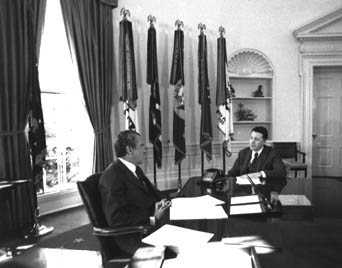 Caspar Weinberger with Nixon. (National Archives) |
By mid-August George Low, the deputy NASA administrator, had reason to believe that piloted flight might survive, if only at a bare-bones level. He wrote, “My own view is that we might be able to bring the 1973 budget back to the 1972 level, but that our chances of bringing it above that level are essentially nonexistent.” The 1972 budget had been too small to launch the Shuttle as a new start, and if future budgets would continue at that level, a shuttle would be out of the question. Taking the bull by the horns, he added that in this situation, “we should drop the Shuttle right now”:
My view is that we should assume that this is a permanent situation, that we should drop the shuttle, and that we come up with a new manned space flight program. In my view, this program should be based on an evolutionary space station development, leading from Skylab through a series of research and applications modules to a distant goal of a permanent space station…. The transportation system for this manned space flight program would consist of Apollo hardware for Skylab; a glider launched on an expendable booster for the research and applications modules; and finally, the shuttle but delayed 5 to 10 years beyond our present thinking. The new element in this plan is the expendable booster-launched glider. The whole program ties together in that none of it is dead-ended. The glider would be both an up and down logistics system for the research and applications modules, and, at the same time, lead toward the development of a shuttle in the future.
The glider would lack engines; it thus would resemble, once again, an enlarged Dyna-Soar. Martin Marietta had advocated such vehicles as recently as 1969; now, with its proposed Titan III-L, it had a launch vehicle suited to this task. Low’s notes amounted to admitting that with piloted flight in extremis, this glider might form the basis of a fallback position that NASA might accept if continued budget reductions were to force the agency to abandon its plans for a Shuttle.
Two days later, in a review of Shuttle configurations and alternatives, Low described the glider more fully:
The glider itself would look somewhat like the shuttle, but would be smaller. It would carry a payload of 12 feet by 40 feet and a payload weight of about 30,000 pounds. It would have sufficient propulsion for on-orbit maneuvering but would not have the engines or propellant tanks required to propel itself into orbit. It would make use of current technology in avionics and other on-board systems. The glider would be placed into orbit with a two-stage vehicle of the Titan IIIL class. The glider and its payload would be reusable but both booster stages would be expended. The requirement for a 15 ft. by 60 ft., 65,000-lb. payload, could be met with the same expendable launch vehicle. [Low, Personal Notes No. 52, August 15, 1971; Low, “Space Transportation System Planning,” August 17, 1971.]
Needless to say, this was not an approach that NASA would embrace willingly. The agency was still a gung ho outfit, deeply engaged even at that moment in sending astronauts to the moon, and its senior officials were not about to go back to Dyna-Soar if they could avoid it. Dale Myers, head of the Office of Manned Space Flight, wrote a memo to Low in which he scoffed at the glider, declaring that its advocates wanted no more than to send an astronaut “‘whirling about the earth’ with no evident use for him in space. In the meantime, these people can get back to doing things as they do them now, with various sized ballistic systems, a relatively constant budget, and a relatively ‘status quo’ sort of operation.”
Leroy Day, deputy director of the Shuttle program, would criticize the glider more pointedly:
You had to put this thing on top of an enormous booster which you had to throw away each time. And so you had an operating cost that was getting to be kind of ridiculous. The vehicle size and everything-it didn’t have much utility. It was kind of a demonstration. It would certainly have been a research vehicle that you could have studied re-entry with. When you got all through with that then you would have said, “Gee, that would be nice if it was big enough to really do something.” Then you would have to turn around and build another vehicle. And with the way the budget climate looked, we were pretty sure that we’d be shut out. We’d never be able to say, “Okay, now let’s start up a real program and build another one that will be an enlarged version and have more capability.” The OMB and Congress would never support it; it would be like two different programs, and we said, “That’ll be the death of it for sure.” [Memo, Myers to Low, September 29, 1971; John Mauer interview, Leroy Day, October 17, 1983, p. 29.]
Then in mid-September, just when it counted, George Shultz, director of the OMB, received a staff memo:
The President read with interest and agreed with Mr. Weinberger’s memorandum of August 12, 1971 on the subject of the future of NASA.
Further, the President approved Mr. Weinberger’s plan to find enough reductions in other programs to pay for continuing NASA at generally the 3.3 – 3.4 billion dollar level, or about 400 to 500 million more than the present planning targets.
Significantly, this approval did not embrace the Shuttle itself. Low writes that during the next two weeks, “Fletcher and I debated whether we should not forego the Shuttle entirely and develop instead some alternative manned space flight program.” Late in September, however, in presenting NASA’s formal budget request for FY 1973, Fletcher screwed his courage to the sticking point and indeed sought funds for a Shuttle.
This budget request took the form of a 13-page letter to Shultz. Fletcher stated, “My minimum recommended program requires budgetary authority of $3,385 million and outlays of $3,225 million for FY 1973.” He placed the Space Shuttle at the top of his agenda, and asked for funding of $228 million: $200 million for research and development, and $28 million for facilities. Three weeks later, in a follow-up letter to Weinberger, he emphasized the Shuttle anew:
Space shuttle development should be started no later than the summer of 1972 [emphasis in original]. Our studies have led to a shuttle concept that minimizes peak funding requirements, and at the same time drastically reduces development cost required for the first manned orbital flight. Yet this concept still leads to a productive space transportation system to meet the needs of U.S. civilian and military space programs. [Memo, Huntsman to Shultz, September 13, 1971; letter, Fletcher to Shultz, September 30, 1971; Low, Personal Notes No. 55, October 2, 1971; letter, Fletcher to Weinberger, October 19, 1971.]
Fletcher, however, was not the only one with ideas on how to build a piloted spacecraft. Within the Flax Committee, reviewing the Shuttle program on behalf of the White House, a member named Eugene Fubini had taken a leading role. He had been the Pentagon’s deputy director of research and engineering, and he had willingly met with the same officials of Martin Marietta who had been recommending the Titan III-L and its glider in lieu of a true Space Shuttle.
Influenced by Fubini, Flax sent an interim report to Edward David on October 19. This report presented a set of alternatives in which the glider, far from ranking lower than the least acceptable form of piloted space vehicle, was actually the most ambitious option that the Flax Committee was willing to endorse. Moreover, the committee’s glider would carry only 10,000 pounds of payload, one-third as much as the version hesitantly considered by NASA’s George Low.
What could be less ambitious than this glider? There was the possibility of modifying Apollo spacecraft to make them refurbishable and continuing to fly them using the existing Saturn I-B, on rare occasions. Another option called for developing the Titan III-M and its Big Gemini, a variant of this existing spacecraft that would grow to carry as many as nine people. Such alternatives might keep piloted space flight alive — but it would resemble a patient on life support.
Flax’s report also addressed the subject of shuttle economics. He dealt specifically with NASA’s preferred concept, which called for concurrent development of booster and orbiter, with the orbiter using phased technology. People described this orbiter as “Mark I/Mark II,” referring to an initial version that would later be upgraded with SSME engines, reusable thermal protection, and advanced onboard electronics.
NASA’s estimated cost per flight was $9.0 million for Mark I, falling to $5.5 million for the improved Mark II. Significantly, and like the OMB, Flax did not challenge these estimates. He merely denied that they promised advantage. As his report stated,
Considering all of the technological and operational unknowns involved in the shuttle development and the fact that no vehicles of similar function have ever been designed before or have ever operated over the range of flight regimes required for the shuttle, prudent extrapolation of prior experience would indicate that estimated development costs may be 30 to 50 percent on the low side. Thus, the estimates of $6.5 billion in RDT&E [cost of development: Research, Development, Test and Engineering] for the Mk I/Mk II shuttle program may range between $8.5 to $10 billion, reflecting increased program costs of $2.5 to $3.5 billion. Similar uncertainties must be considered to apply to other non-recurring costs such as production and facilities (amounting to about $4 billion). Thus a possible cost uncertainty of about $5 billion for total program costs might be envisioned giving a high estimate of total non-recurring cost of about $15 billion.
At a launch rate of about 40 per year (DOD, NASA and other) over the 13 years used in the NASA cost model and an average payload cost of $30 million (not unrepresentative of the mix of current unmanned payloads), the total payload costs would be $15.5 billion. Thus, even if the total payload cost were saved (including those launched to Mars, Venus, etc.) over a 13-year period by recovery and reuse at zero refurbishment cost, it would, in the case of the high-end cost estimate, barely offset the cost of the shuttle program without discounting. A more realistic (although probably generous) estimate of the savings possible through payload recovery might be 50 percent of payload costs which could account for only $7.5 billion.
The other area of savings which is offered by the shuttle is its launch cost. Average launch cost with current expendable boosters is $12 million (projected into the 1978-90 era in the NASA cost model). Thus, with current expendable boosters, the annual launch cost will be $500 million. The cost of Mk II shuttle operation per flight is usually cited at $5.5 million; thus the cost for 40 flights per year will be $220 million. The saving of $280 million annually for 13 years amounts to $3.6 billion. However, a doubling of the operational cost would reduce the saving to $60 million annually or $780 million….
The operating cost estimates of $5.5 million per flight for the shuttle, within narrow limits, must be considered to be a very rough estimate at this time, particularly for the early years of shuttle operation. The actual value will depend upon the time between overhaul of equipment not yet designed, refurbishability of thermal protection system materials not yet out of the laboratory, and on the feasibility of operating in the shuttle in an “airline” mode radically different from all past experience in space operations. [Note, Frank Williams to Von Braun, August 23, 1971; Low, Personal Notes No. 56, October 17, 1971; letter, Flax to David, October 19, 1971.]
These few paragraphs delivered a body blow to the Shuttle’s economic prospects, for although their conclusions were highly unfavorable, they actually carried a strong bias in favor of the Shuttle. This was because this analysis used current or undiscounted dollars. The Mathematica study had moved heaven and earth to try to justify the Shuttle in dollars discounted at ten percent per year, and members of the Flax Committee had little use for that study’s findings. In the words of a committee staff member, “No one believed all the fancy economics and no one believed the mission model. I think they were on hemp when they were talking about sixty flights per year.” Yet it had seemed easy to show that the Shuttle could be cost-effective in undiscounted money.
Now, however, Flax was saying that the Shuttle would fail this test as well. NASA might have moved mountains to try to cut the Shuttle’s cost of development, but the complete nonrecurring cost, taking account of a plausible overrun, could easily approach $15 billion. The undiscounted savings, with a reasonable mission model and an optimistic cost per flight, would barely top $11 billion and could be less. The OMB economist John Sullivan, who had made Shuttle studies his specialty, summarized the matter within a memo to Don Rice: “A Shuttle cannot be justified when using cost-effectiveness as the criterion.”
Nevertheless, no one wanted to shut down the piloted-flight effort. In early October, Low wrote of a meeting with the OMB’s John Young:
I took Jack Young to lunch about a week ago, largely because I had heard that he was the one most negative toward manned space flight within OMB. During our discussions, he agreed that the manned space program and the unmanned planetary programs were the big swing factors in the NASA budget. He indicated, however, that he understood that only the level of manned space flight was in question and not whether to have a manned space flight program at all. He agreed that the President would not, and could not, stop the nation’s manned space flight effort. [Memo, Sullivan to Rice, October 19, 1971; Low, Personal Notes No. 55, October 2, 1971; John Logsdon interview, Dave Elliot, p. 3.]
Yet if piloted space flight was to involve more than infrequent missions in which astronauts would show the flag, then NASA would need help, and in a hurry. The help came from Mathematica, which now gave a strong endorsement to a preferred Shuttle configuration.
TAOS: A New Alternative
The Mathematica analysis of May 31 had drawn criticism because it had dealt only with the two-stage fully-reusable approach of Phase B, paying no heed to design alternatives. Yet a comparison of such alternatives, on economic grounds, promised insights that even the Flax Committee was willing to pursue. Flax’s interim report stated that while direct cost-benefit analysis lacked “sufficient credibility to serve as a primary basis for deciding to undertake such an expensive and high-risk program,” economic comparisons “are undoubtedly extremely valuable in making cost tradeoffs and in considering alternatives in design and program planning.”
In studying such alternatives, designers traded reduction in development cost against an increase in cost per flight. This tradeoff had to stay within bounds; if the cost per flight was too high, the Shuttle would fail to capture traffic from existing expendables. Yet the Mark I orbiter, as discussed in Flax’s report, would cost $9 million per flight, comfortably under the $12 million of expendables. This was enough of a margin to give this design a strong advantage.
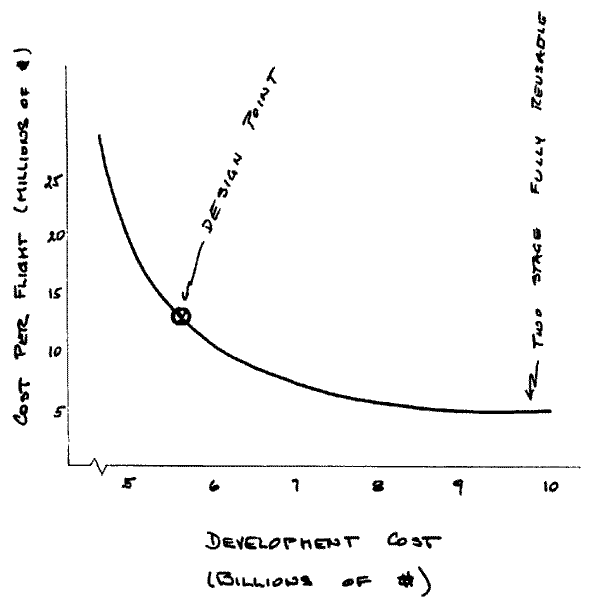 Sketch made by George Low in 1979, illustrating the trade-off between cost per flight and development cost. (Drawing by George Low courtesy John Logsdon) |
Klaus Heiss, who was continuing to direct the Mathematica studies, was not in a position to introduce new design concepts of his own. Instead he proceeded by receiving the contractors’ concepts, comparing them using methods of economics. As he pursued such comparisons, he concluded that NASA had not pushed its tradeoffs far enough. The opportunity existed to push the cost per flight as high as $10 million, in exchange for a further reduction in development cost and in peak annual funding. Even at $10 million per flight, all but five percent of the Shuttle’s planned missions would remain cost-effective when compared with similar missions using expendable launch vehicles.
Heiss saw that a specific class of Shuttle designs would do this. He called this class TAOS (Thrust Assisted Orbiter Shuttle). It would use a standard orbiter, possibly of the Mark I/Mark II type, with an external tank large enough to permit the orbiter’s engines to operate with “parallel staging,” burning from liftoff to orbit. Two booster rockets would flank this tank, giving added thrust after liftoff, then falling away at staging velocity. The boosters might use pressure-fed liquid-fuel engines. Alternately, they could use solid propellant.
“If you could go to $10 million,” Heiss later told National Journal, “then some kind of thrust-assisted orbiter shuttle beat out all other systems. It had the lowest development costs of any system capable of sustaining continuous manned flight.” [Letter, Flax to David, October 19, 1971, p. 6; National Journal, August 12, 1972, pp. 1298-1299.]
Such designs already existed. McDonnell Douglas had one called RATO, Rocket Assisted Take-Off. It put the orbiter’s propellants in two external tanks, with a 180-inch solid rocket mounted to the belly. Grumman had TAHO, Thrust Assisted Hydrogen-Oxygen, with a single external tank flanked by twin pressure-fed liquid boosters. This background meant that key NASA contractors already had people who had introduced TAOS concepts and had studied some of their engineering issues.
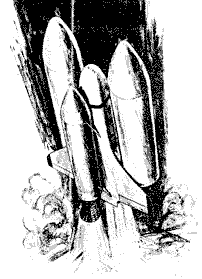 Example of a TAOS. Grumman concept of a shuttle with a single large solid-propellant booster and propellants in external tankage. McDonnell Douglas had a similar concept called RATO (Rocket Assisted Takeoff). (Grumman) |
For TAOS, the 260-inch solid motor would not do. It would be difficult to develop, hard to handle due to its enormous size, and yet it would offer no cost advantage. The TAOS approach, however, specifically included the selected Shuttle configuration of 1972, with twin solids, smaller in size, for the booster. Ironically, this specific configuration appears to have originated within the Institute for Defense Analyses, the think tank whose president, Alexander Flax, was challenging NASA’s approaches so effectively.
The IDA had close ties to the Air Force, which had been using solid boosters for years on the Titan III, and NASA’s Charles Donlan gives credit for the twin-solid TAOS to two IDA staffers, Reinald Finke and George Brady. In 1986, Donlan declared that “Brady came up with the configuration that’s almost identical” to the one that NASA built. “And so a year or so ago, I recommended that NASA give him one of their awards, when they were recognizing Shuttle contributors.”
During 1971, however, TAOS had a strong disadvantage: those booster rockets, whether with liquid or solid propellant, would be unpiloted. NASA still was pinning its hopes on a piloted booster, quite possibly the winged S-IC, and its officials paid little heed to Heiss’s proposals. Heiss knew why: “In the first place, there was the irresistible urge to go for the most advanced design and technology possible. And then there was a deep-seated bureaucratic bias for two manned vehicles.” There also were the institutional prerogatives of NASA-Marshall, which might accept pressure-fed liquid boosters in a pinch, but had little background in solids. The OMB’s Don Rice would note that NASA “pushed so hard for the liquid fuel thing in the first place, because it was hard to find something for Marshall to do. A reason to keep Marshall around if they didn’t have one of those big booster development programs underway.” [Report B35-43 RP-28 (Grumman); Interim Report (McDonnell Douglas), pp. 13, 25; John Mauer interview, Charles Donlan, October 19, 1983, pp. 28-29; John Logsdon interview, Donald Rice, November 13, 1975, p. 2; National Journal, August 12, 1972, p. 1299.]
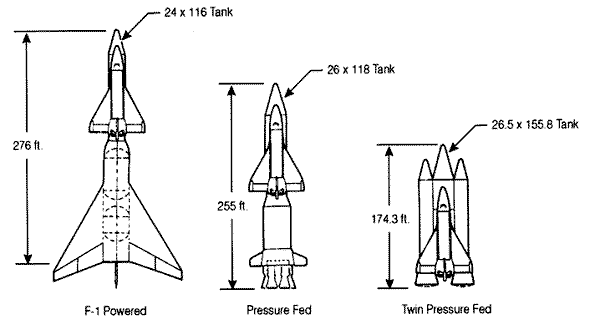 Booster concepts of autumn 1971, with a winged S-IC at left. Configuration at right is a TAOS. All three alternatives were to boost the same orbiter, which would carry all its propellant in a single expendable tank. (McDonnell Douglas) |
Heiss nevertheless pressed the case for TAOS within NASA, working with Robert Lindley, the director of engineering and operations within the Office of Manned Space Flight. Lindley had carried out initial cost-benefit studies of the Shuttle, as an in-house NASA effort, and had worked closely with Heiss when Mathematica pursued its subsequent efforts. Heiss would describe Lindley as “one of the few people over there to grasp clearly the real economic and design tradeoffs.”
Through September and October, Heiss and Lindley exhorted McDonnell Douglas and Grumman to include TAOS designs in their presentations to NASA. Says Heiss, however, “some NASA officials kept telling them to forget it, the configuration had no chance.” As late as October 15, in a presentation to the Flax Committee, NASA failed to include TAOS. Toward the end of the month, Heiss adds, “we thought the whole program was on a catastrophic course.
“There were still many people in NASA who believed they could sell the Administration an $8-billion to $10-billion two-stage flyback system,” which might be even more ambitious than the phased-technology orbiter with winged S-IC. “At the other end of the spectrum, the OST [White House Office of Science and Technology] and OMB seemed to be drawing back toward some kind of advanced expendable system,” based on the Titan III-L or the even less capable Titan III-M. A major shuttle design review loomed during November, and in Heiss’s words, “We decided to try and get to Fletcher.”
Heiss and his boss, Oskar Morgenstern, wrote a 15-page report that called strongly for TAOS. Under standard procedures, they would have submitted it through channels; senior officials with axes to grind could have sat on it or downplayed it before the report could reach the policymaking level. Instead, Heiss and Morgenstern sent it to Fletcher directly. “Those who say Mathematica was a kept child of NASA really don’t know what they’re talking about,” Donlan later said. “Morgenstern was nobody’s kept child. In fact, we had no way of controlling what he did.” [National Journal, August 12, 1972, p. 1299; John Mauer interview, Charles Donlan, October 19, 1983, p. 28.]
The conclusions of his report dealt not only with the Shuttle but addressed the Space Tug, a reusable rocket stage intended to carry spacecraft to and from high orbit:
The TAOS concept foregoes the development of a Two Stage Shuttle System. With the use of thrust assists of either solid rocket motors or high pressure feed systems — which can be made in part reusable for low staging velocities — the TAOS concepts promise a reduction of the non-recurring costs (RDT&E and initial fleet investment) from about $9 billion or more (two stage systems, including reusable S-IC) to about $6 billion or less, with a minimal operating cost increase, if any, in the operating phase of the TAOS system.
The detailed economic justifications of the TAOS concept — when compared to any two stage reusable system are:
1. The non-recurring costs of TAOS are estimated by industry to be $6 billion or less over the period to 1979 or to 1984-85, depending on the objectives and choices of NASA.
2. The risks in the TAOS development are in balance lower but still substantial. Intact abort with external hydrogen and oxygen tanks is feasible; lagging performance in the engine area can be made up by added external tank capacity. A large reusable manned booster is not needed.
3. The TAOS’s that were analyzed promise the same capabilities as the original two stage shuttle, including a 40,000 pound lift capability into polar orbit and a 60 x 15 feet payload bay.
4. The TAOS can carry the Space Tug and capture high energy missions from 1979 on.
5. The most economic TAOS would use the advanced orbiter engines immediately. Our calculations indicate that among the alternative TAOS configurations an early full operational capability (i.e., high performance engines on the orbiter) is economically most advantageous, and feasible, within budget constraints of $1 billion peak funding.
6. The TAOS can use J-2S engines on the orbiter for an interim period.
7. The TAOS abolishes completely the immediate need to decide on a reusable booster and allows postponement of that decision without blocking later transition to that system if still desired. Thereby, TAOS eliminates or lowers the risk and potential cost overruns in booster development.
8. The TAOS can use “parallel burn” concepts, which, if feasible, may change the reusable booster decision.
9. Technological progress may make tank costs, and thrust assisted rocket costs less expensive, thus further aiding TAOS concepts when compared to two stage concepts.
10. TAOS assures NASA an early program definition, and a purpose to the agency. An agreement on TAOS will allow NASA Headquarters a quick and clear reorganization of major NASA centers to meet the TAOS development requirements economically.
11. The TAOS funding schedule makes an early Space Tug development possible. The Space Tug is an important part of the Space Shuttle System. A 1979 Space Tug should recover its complete development costs before 1985 even with the stretched build up of Space Shuttle missions from 1979 to 1985.
12. A clear policy on TAOS development will give an incentive to European countries to undertake and fund the Space Tug development — thereby possibly even eliminating Space Tug funding from NASA budget considerations.
13. The cost per launch of TAOS can be as low as $6 million or even less on an incremental cost basis, with reuse of parts of the thrust assist rockets (either SRM or pressure-fed). With Point 9 realized, the costs of TAOS would practically match the costs per launch of the two stage fully reusable system.
14. TAOS practically assures NASA of a reusable space transportation system with major objectives achieved. [Heiss and Morgenstern, Factors. Reprinted in NASA SP-4407, Vol. I, pp. 549-555.]
Like Grumman a few months earlier, Mathematica, with Point 13, was not above assuring Fletcher that he might have his cake and eat it too. This low cost per flight indeed might be attained — but only if it proved possible to dunk a pressure-fed booster into the Atlantic and fish it out none the worse for wear, ready for refurbishment and reuse at minimal cost. Contractor studies, however, soon supported Mathematica’s high hopes, showing that TAOS indeed offered low cost — and that solid boosters promised costs that were lower still [Reports MDC E0497 (McDonnell Douglas), p. 1-23; B35-43 RP-30 (Grumman), pp. 2, 17]:
| Concept | Development cost, $ B | Peak annual funding, $ B | Cost per flight, $ M |
| . | |||
| Grumman: twin pressure-fed | 4.02 | 0.97 | 8.2 |
| McDonnell Douglas: twin pressure-fed | 4.83 | 0.74 | 6.4 |
| McDonnell Douglas: twin solid motors | 4.34 | 0.71 | 9.9 |
TAOS did not take NASA by storm. Its design concepts were already part of the mix of alternatives; they had merely been languishing for want of attention. TAOS, however, proved highly useful as it provided a fallback concept, less costly than the winged S-IC, which NASA would adopt as it continued to yield to pressure from the OMB.
A Time to Decide
For NASA, it was time to have the OMB fish or cut bait. Fletcher had submitted his budget request on September 30, with a line item of $228 million to initiate Shuttle development. This NASA request was one of many budget proposals from federal agencies and cabinet departments; the OMB would modify them and then assemble them into the President’s budget, which would go to Congress early in 1972. An early milestone in this budget process, the Director’s Review, included a session titled “Space and General Research.” Weinberger ran those reviews in 1971. They represented meetings at which OMB staff would recommend actions on agencies’ requests, with Weinberger being free to respond. Following standard rules, NASA officials would not be present.
OMB staff members were well prepared for this session. A staff paper, prepared in early October, admitted that the use of a single pressure-fed booster would be more cost-effective than use of the winged S-IC. This represented a response to NASA’s booster alternatives of September; the pressure-fed option was a rocket stage of the usual type, and the Shuttle was not a TAOS. While this configuration looked better than the alternative, it still was not good enough. The paper concluded that the most cost-effective option of all, more so than any shuttle, was an uprated Titan III with Big Gemini.
By contrast, Fletcher wanted his shuttle and he wanted it very soon. In a letter to Weinberger of October 19, he pressed his point:
The aerospace industry will be hurt by continuing indecision and further delay in the shuttle program. A firm go-ahead, on the other hand, will quickly create jobs in the industry.
It will not be possible to sustain the momentum now built up in the shuttle program much longer. A loss in momentum will have serious and costly consequences, and may even be irreversible. [Letters: Fletcher to Shultz, September 30, 1971; Fletcher to Weinberger, October 19, 1971; NASA, “Documentation of the Space Shuttle Decision,” February 4, 1972; Space Policy, May 1986, p. 112.]
It would not be possible to maintain the Shuttle effort indefinitely as an exercise in design study and analysis. The aerospace industry was set up to build, not to dither endlessly. Its preliminary-design groups, which had carried forward the Shuttle work to date, practiced a highly skilled and specialized trade; if their efforts were not to bear fruit, their companies would be weakened unless senior management could reassign these people to the preparation of other proposals.
NASA’s Director’s Review session took place on October 22, and the OMB staff recommendation was blunt: cancel the Shuttle program. Staff members also proposed that if this was not feasible, the decision should be held off for another year, when the OMB would deal with the budget for FY 1974. Weinberger was not eager to accept such options. Neither was he willing to flatly override his staff, even though this was his prerogative, and endorse NASA’s position. NASA wanted the Mark I/Mark II orbiter with winged S-IC booster, and Weinberger was interested in alternatives studied by the Flax Committee.
That committee had held a key meeting only a week earlier, with the OMB staff economist John Sullivan attending as an observer, and Flax had reviewed shuttle alternatives only three days earlier, in his interim report to the White House’s Edward David. These alternatives included the glider. As Weinberger later described the meeting,
The staff, in effect, decided they weren’t going to do it. The staff then told me that, if we wanted to do it, it could be done less expensively. So I was delighted to hear that; and so they went back and worked with NASA to work out a different configuration.
I could have cut it off at the Director’s Review and insist that we are going to do it the way NASA wants it. But the opportunity to do it at a lower cost on additional analysis appealed to me. I never had any doubt in my own mind but, one way or another, I wanted to do it. I thought it was the proper thing for the government to do at that time, and that we needed some forward-looking new activities geared toward the future instead of the past.
With Solomonic precision, Weinberger then split the difference between the views of NASA and of his staff. He told Don Rice that some sort of shuttle indeed would be approved; NASA would not have to settle for Big Gemini. Rice and his staff, however, would have a free hand to seek lower costs. If this meant that NASA would wind up with nothing more than the glider — well, no one in Washington expected the OMB to come forward as a bearer of gifts. [NASA, “Documentation of the Space Shuttle Decision,” February 4, 1972; John Logsdon interview, Caspar Weinberger, San Francisco, August 23, 1977, pp. 5, 13; Space Policy, May 1986, p. 113; Science, 30 May 1986, pp. 1102-1103.]
NASA had some support on the White House staff, but its critics were both numerous and well-placed. In mid-November, George Low gave a summary view of the players that reflected the assessments of William Anders, a former astronaut who now was running the interagency National Aeronautics and Space Council:
Weinberger: is a real space buff. The only one in OMB really positive toward the NASA program. Causes Rice to over-balance in the opposite direction. Everybody lower in OMB is negative.
Rice: the most knowledgeable opposition comes from Rice. Feels that NASA is out of control; however, he will probably support a glider on a TITAN IIIL.
Ed David: was noticeably quiet, measuring his words, and repeatedly saying that he only represented science and that other factors are also involved…. Not really plugged into the President.
Flax: Fubini is really running the Flax Committee. Flax apparently states that no program as large as the Shuttle will gain continuing support. We need a less costly program…. Anders feels that Flax is driving David toward the glider and not vice versa. Anders believes David will support the Orbiter with the parallel staged pressure-fed booster if Flax so recommends.
Whitehead: Whitehead could be helpful in making Flanigan a meaningful communications link to the President, which Anders believes Flanigan needs to be. Whitehead’s main motivation now is to improve the Fletcher/Flanigan communications link. Whitehead can be extremely helpful in selling the NASA desired Shuttle approach…. Believes in a $3.5 billion NASA.
Rose: is the California unemployment buff in the White House. Tries to be helpful and sees Flanigan all the time. He defers to Whitehead when Whitehead is present.
Flanigan: states that the Shuttle story is improving; however, he is by no means convinced that there should be a Shuttle. Is strongly influenced by Whitehead, Rose and David.
Peterson: is the most negative of all about NASA. Perhaps the most dangerous opposition we have within the White House. Believes the space program is the place to take money to stimulate technology. Asked why not take $1 billion out of space and who needs manned space flight.
Ehrlichman: asked the question, “Given the public attitude on space, why not put the money in aeronautics?” However, he is very much concerned about the aerospace industry and will probably go along with whatever OMB/OST/Flanigan recommend. [Low, Memo for Record, November 15, 1971.]
These were not the scoundrels featured in the subsequent bestseller on Watergate, All the President’s Men. Though skeptical, they were open to argument and perhaps even to persuasion, and it was up to Fletcher and Low to try to sway them.
On November 22, Fletcher responded to a request from Jonathan Rose, a member of Flanigan’s staff, and sent him a 10-page paper that presented NASA’s case for the Shuttle. On that same day, Low addressed a request from Rice and offered his own paper, which gave a reply to Flax’s interim report of a month earlier. Flax had discussed a range of alternatives that included Big Gemini and a small glider. Low now gave his own range of alternatives, with each receiving a succinct description. Big Gemini was conspicuous by its absence, but in other respects, Low’s list covered the most important configurations of 1971.
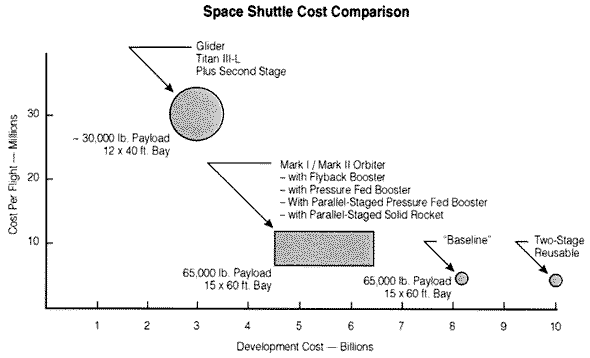 Alternate concepts of November 1971, showing cost per flight and development cost. Compare with sketch by Low above. (NASA) |
At the high-cost end of this list were two-stage reusables, both the fully-reusables of Phase B and the variant with external hydrogen tanks on the orbiter. In the middle was the Mark I/Mark II orbiter with a single large tank carrying both propellants, and four choices of booster: winged S-IC, single pressure-fed first stage, TAOS with twin pressure-fed boosters, TAOS with twin solids. Anchoring the low-cost end was the Titan III-L with a glider carrying payload of 30,000 pounds. Low recommended a version of TAOS: “The most promising candidate configuration today is the Mark I/Mark II orbiter with the parallel-staged pressure-fed booster,” with all engines burning at liftoff.
Low also went to a meeting of the Flax Committee and drew a diagram on a blackboard, summarizing the points of this paper. Fletcher sent a copy to Edward David at the White House, with a cover letter:
All of these configurations of the Shuttle can be developed for costs substantially below those we planned six months ago. We have progressed to the point where a decision to proceed with the shuttle in connection with the FY 1973 budget process is definitely in order. [Memo, Fletcher to Rose, November 22, 1971; letters: Low to Rice, November 22, 1971; Fletcher to David, November 24, 1971; Low, Personal Notes No. 59, November 28, 1971.]
Needless to say, the OMB staff had its own views of the matter. Low’s glider had a 12 x 40-foot payload bay; it was the lowest in his range of options, but was the most ambitious of OMB’s. On November 29, OMB staffers Daniel Taft and John Sullivan sent their own memo to Rice:
Even a small (10′ x 20′) glider could capture all manned space flight traffic, e.g.: Space station visits and return to Earth (station modules could be launched unmanned by expendable rockets).
Since the Shuttle is not an economic system under optimistic assumptions, the importance of whether or not all of the payload benefits are realized becomes less significant. The important factors are really such considerations as national prestige, continuation of a manned space flight program, and advancement of technology. Any of the reusable vehicles discussed in this paper (even a 10′ by 20′ glider) provide this type of intangible benefit.
A 10′ x 20′ glider would provide virtually the same intangible benefits as a 15′ x 60′ orbiter for less than half the investment cost.
A 12′ x 40′ glider or orbiter would provide more operational experience with larger payloads than would a 10′ x 20′ and hence would make it easier to grow to a larger system should that later be desired. [Memo, Taft and Sullivan to Rice, November 29, 1971.]
The elements of a consensus now appeared to be at hand. Following Low’s presentation to the Flax Committee, its members felt that NASA had “finally come around to something reasonable” — with the reasonable thing being the glider, not the TAOS booster and orbiter. Such a glider also appeared on the option lists of both Low and the OMB staff. Within the White House, Flanigan met with two of the top executives of North American Rockwell. He told them that there definitely would be a Shuttle program, that the government was about ready to make the decision, but that some issues still had to be sorted out.
Weinberger had already rejected Big Gemini; Low now argued against the glider. Lacking its own propulsion, it could not make use of designs such as TAOS to keep the cost per flight within bounds. Instead, a glider would require its own two-stage rocket, which would drive the cost per flight as high as $35 million. Low met with Rice, Whitehead, Rose, and Edward David, and wrote that “we demonstrated quite conclusively that a glider would not be cost-effective. Apparently, we also made considerable headway with all the glider advocates in convincing them of this point.”
A moment of decision came on December 2, as the OMB sent Nixon a Memorandum for the President. It dealt with space policy, covering a range of issues. The memo included a two-page discussion of the Space Shuttle, and presented the OMB’s recommendation: “a smaller reduced cost version of a manned reusable Shuttle with an investment of $4-5 billion over the next 8 years — less than one-half NASA’s original proposal.” With a stroke of his pen, Nixon would grant his consent:
| . | Approve | Disapprove |
| . | ||
| 1. Initiate reduced-cost smaller Space Shuttle program | . ______ | . ______ |
| 2. Conduct Soviet docking mission | . ______ | . ______ |
| 3. Conduct other manned earth-orbital missions | . ______ | . ______ |
| 4. Apollo 16 and 17 | ||
| Cancel both missions | ______ | ______ |
| Cancel just Apollo 16 | ______ | ______ |
| Reschedule Apollo 16 and fly both | ______ | ______ |
For NASA, however, this Shuttle that would fit the budget amounted to a throwback to earlier years, when NASA had considered only its own needs and had not yet introduced the large payload capacity that the Air Force would demand. The new shuttle would not be a glider; it would have its own propulsion. It would, however, carry only 30,000 pounds, in a 10 x 30-foot bay. It offered considerably less than the lowest-cost version of TAOS considered to date.
For months, NASA’s senior administrators had been fighting with the OMB, which time and again had pressed for less costly designs. These same administrators then had to turn around and act as an in-house version of OMB, pressing their engineering managers to pursue such designs. These managers operated at the working level; meetings with Weinberger or Flanigan took place far over their heads. They liked the two-stage fully reusable Space Shuttle; they had nurtured it and did not want to give it up. Low and Myers thus had to put a good deal of effort into keeping their troops in line.
This internal NASA debate, paralleling that between NASA and the OMB, brought such contretemps as Max Faget’s reluctance to accept Air Force requirements, the resistance that Heiss and Lindley encountered when they advocated TAOS, and insistence at NASA-Marshall that the booster had to be liquid-fueled. The December 2 Space Shuttle, which the OMB proposed and Nixon endorsed a week later, fell outside the bounds of what NASA was willing to take. Fletcher, dealing with both the White House and the OMB, would promptly declare that it was unacceptable. [OMB, Memorandum for the President, December 2, 1971; OMB, “Space Shuttle Program,” December 10, 1971; Low, Personal Notes No. 60, December 12, 1971; letter, Low to John Logsdon, January 23, 1979.]







